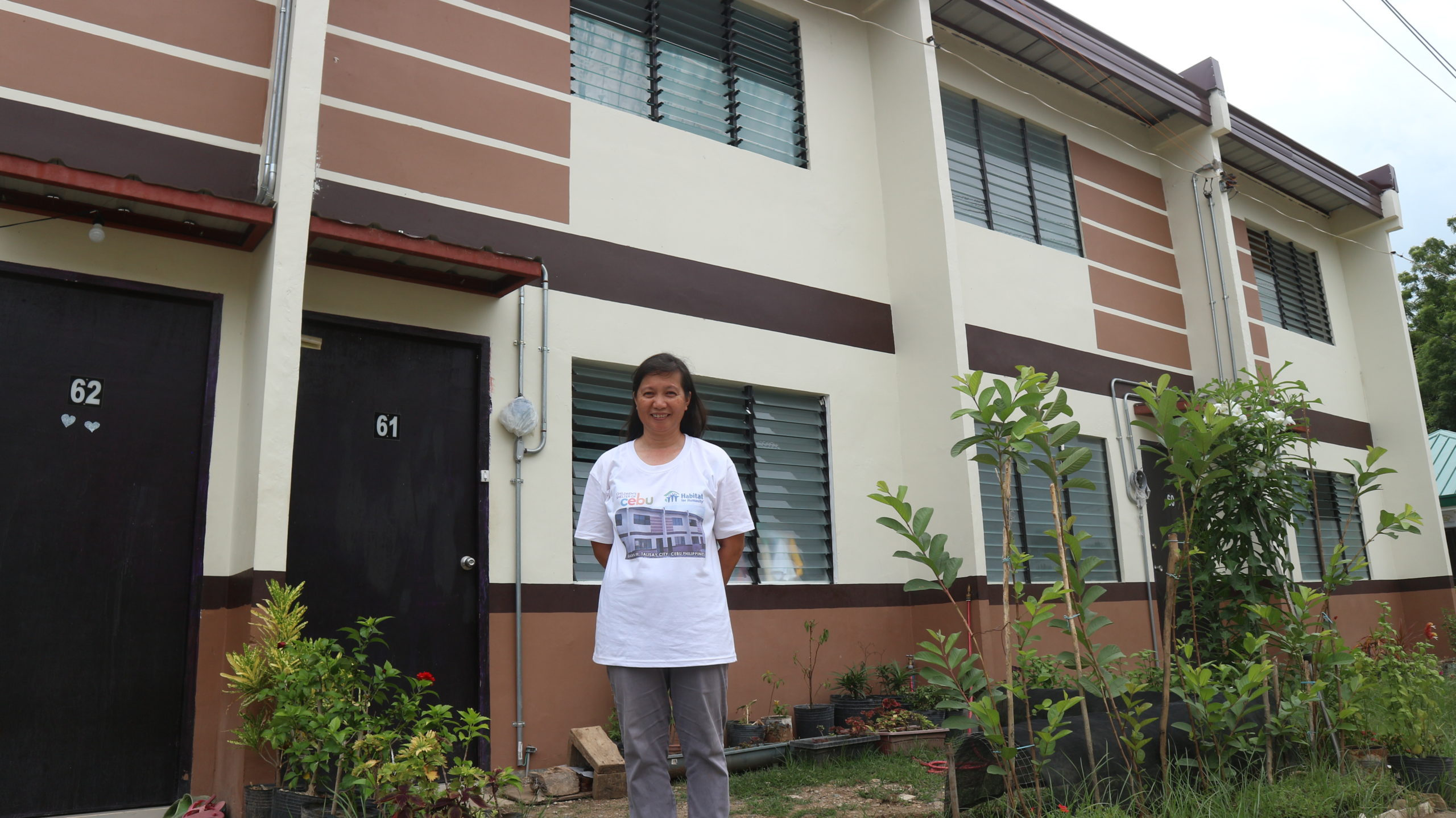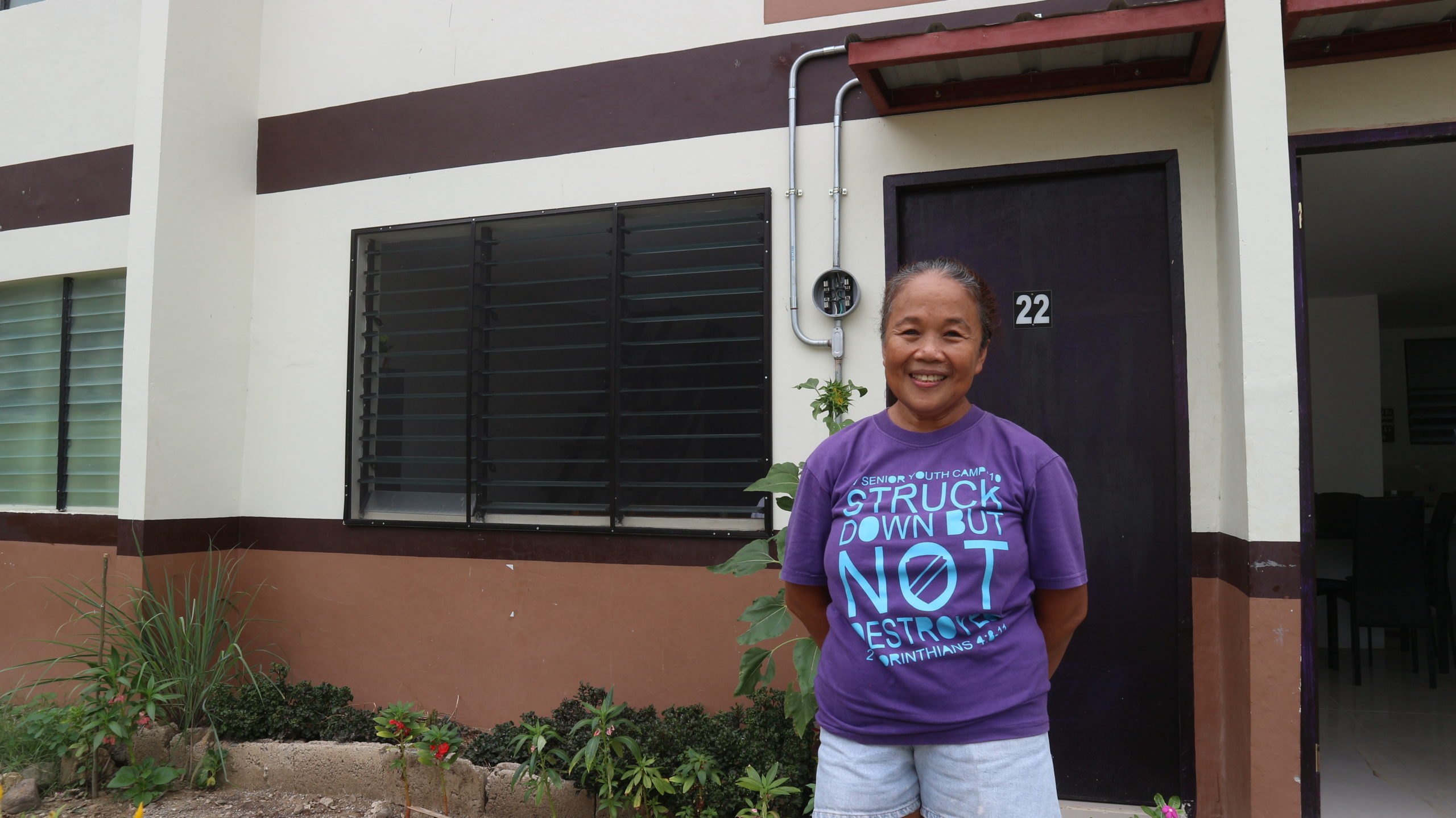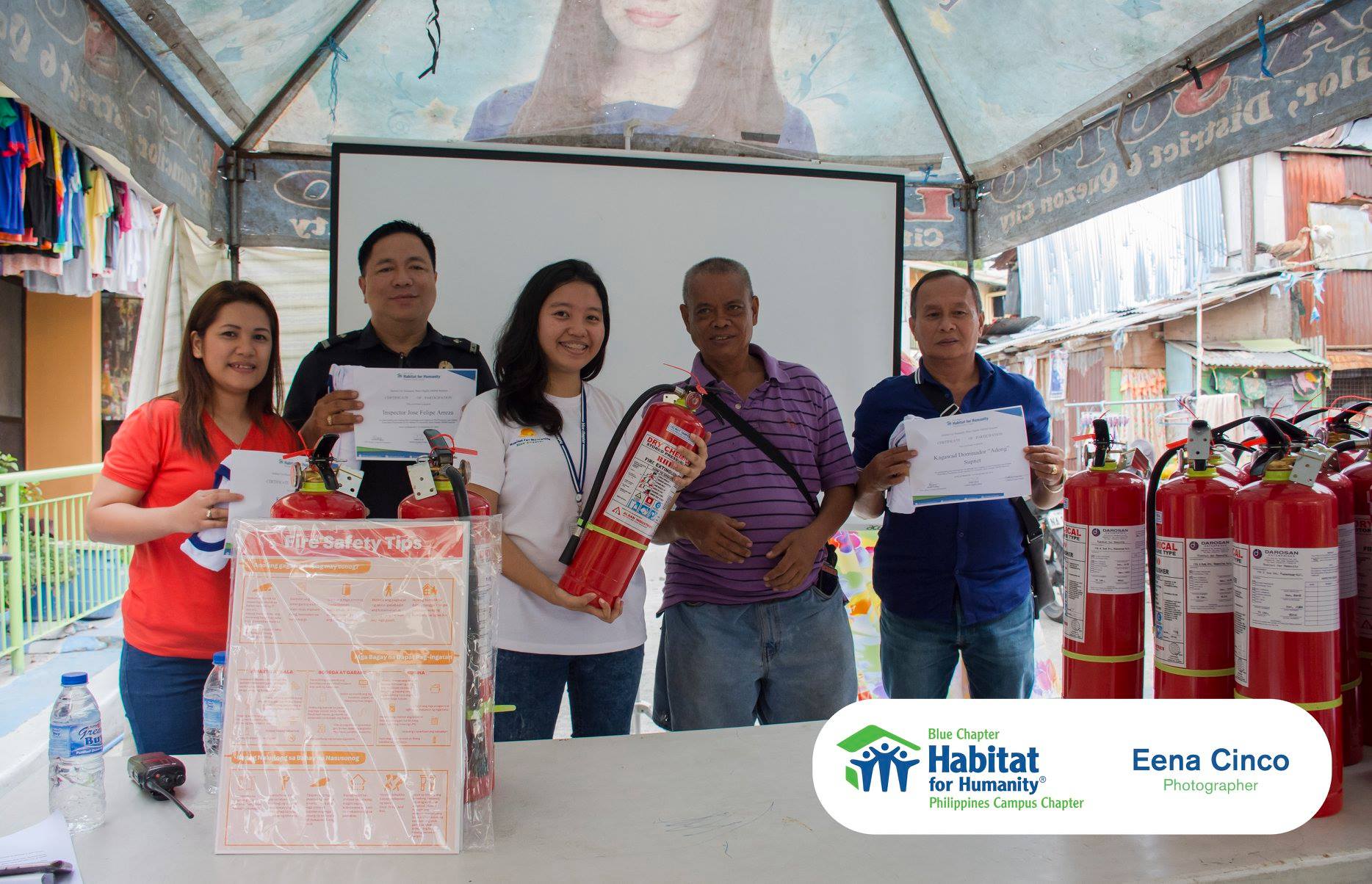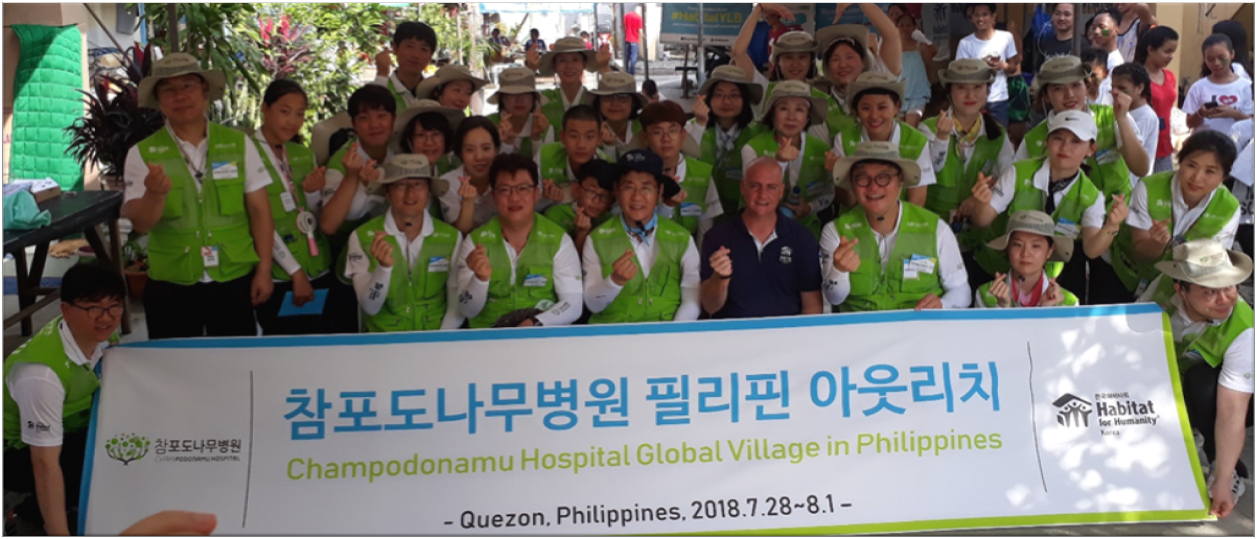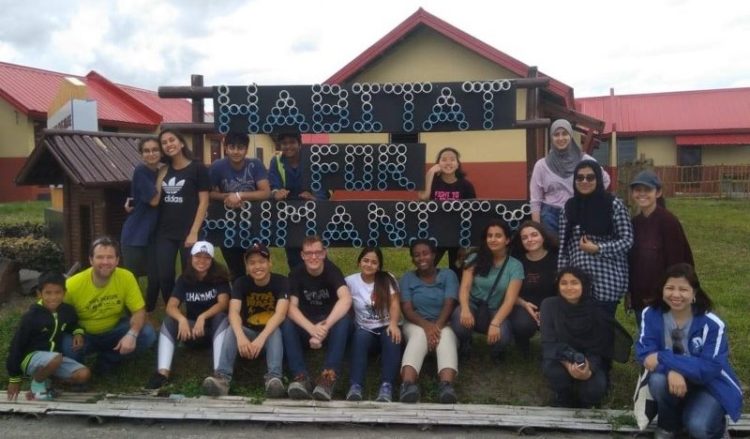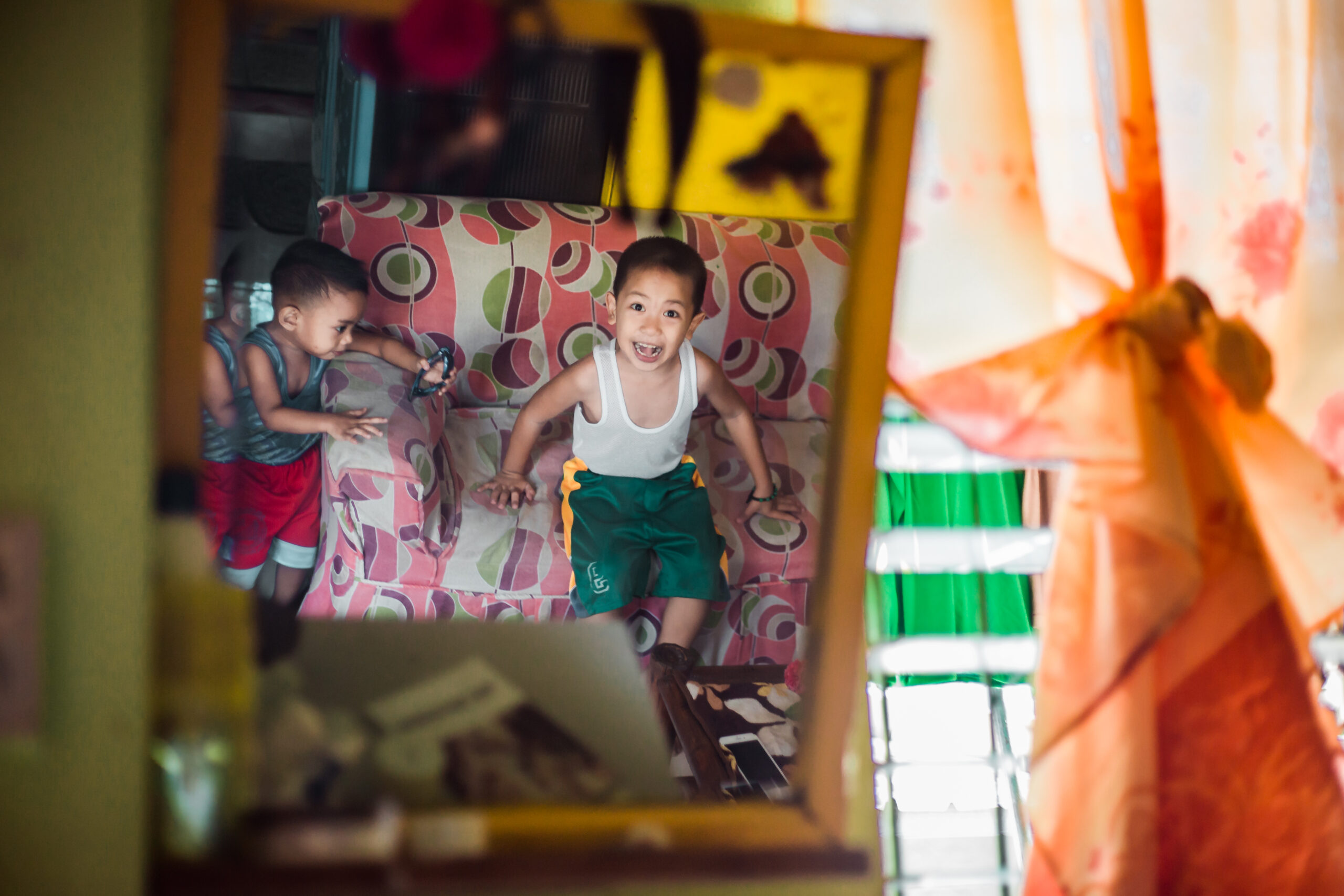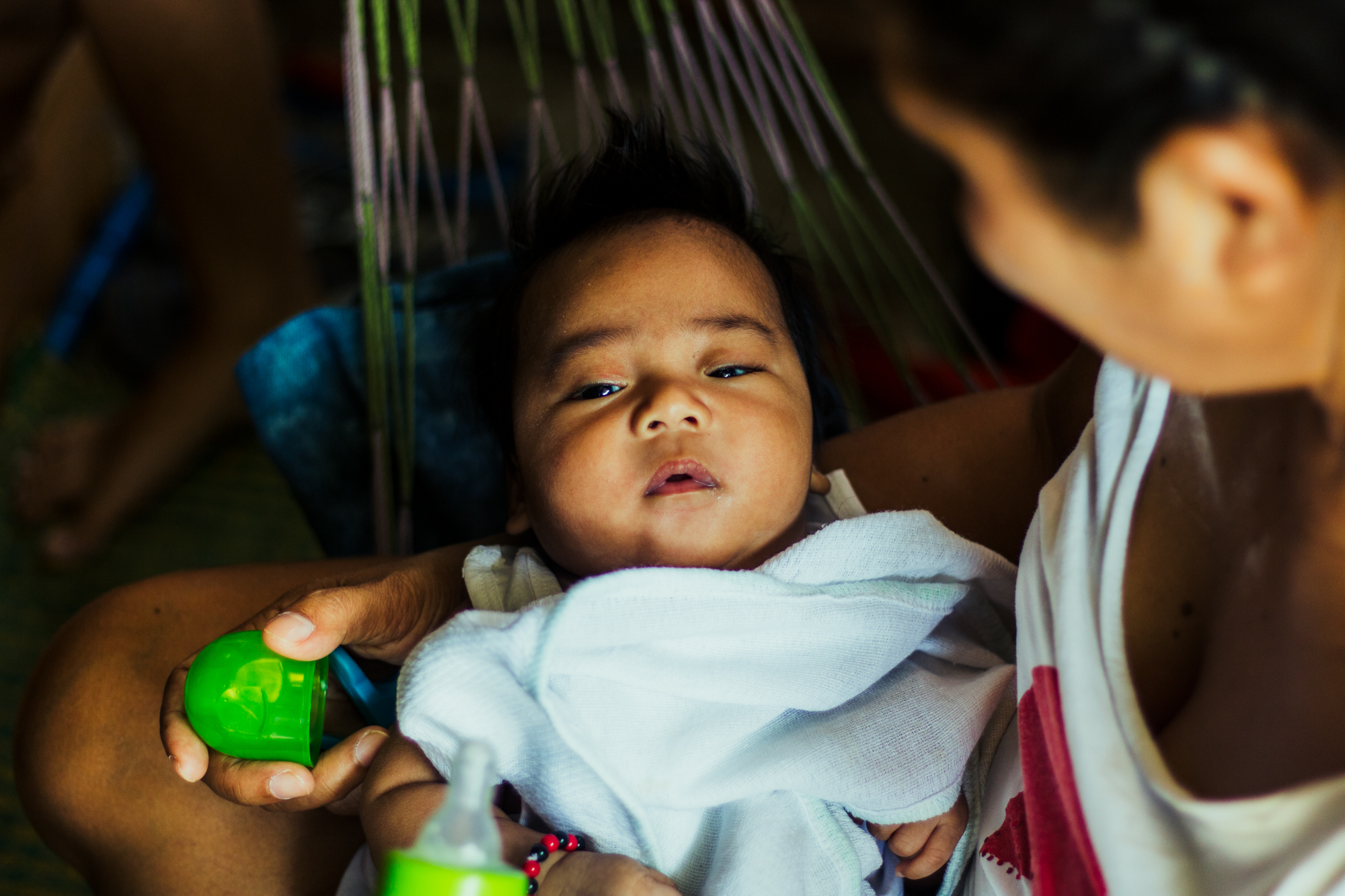
Every Habitat home is built with unique stories.
These stories live within and outside its walls – from the journey of the family who lives in it to the experiences of the people who have made it possible. See the face of strength, hope, and resilience through stories that capture the value of a decent home in “Faces of Habitat.”
Dream to Legacy
The year was 2000. Alma Narciso, then 30 years old, had just given birth to her child when a strong storm caused massive flooding in parts of Metro Manila. Alma and her family lived by the riverside in San Miguel, Manila, one of the gravely affected communities.
“It only took seconds. When I came out to check, the water was already chest-deep. Our roof was blown away, and my partner had to chase after it. I was really nervous. I got sick because of that,” recalled Alma.
Whenever there’s a typhoon or heavy rains in their previous place, it would usually take a month or two before the flood would subside. She was constantly worried about the leaking roof and the environment where her children were growing in. But even without a storm, there’s always that fear that they would be forced to leave their place because they were informal settlers.
“I was always anxious because my kids were still young at that time, and they were all studying. My partner and I used to pick up scraps from the dumpsite and took side jobs just to provide for the family. If we’re forced to leave our place, where would we go? Where would they take us? If we needed to pay a monthly rent, what about our food and other daily needs,” said Alma.
The moment that she feared the most came, and they immediately had to leave the place. The local government offered to relocate them to Montalban, Rizal. But they rejected it because it was too far from their source of livelihood. So, when another opportunity knocked on their door to move to a housing project in Pasig City, they didn’t hesitate to take it.
Just like other families, who got the chance to have a Habitat home, Alma and her family did 1,000 hours of sweat equity, clearing the project site, laying bricks, and ultimately building their home. To them, it was a fulfilling experience to work alongside other families.
“It was challenging, but we were happy. A lot of families worked together. I’m glad that we now live in a house that we helped build,” said Alma, adding, “I’m truly grateful and overjoyed because this it the fruit of our hard work. We don’t have to fear the storm anymore.”
Alma and her family moved into Habitat Pasig 2 community in Pinagbuhatan, Pasig City, in 2012. The house was named after her mother, who had bone cancer and passed away shortly after they transferred. The move-in was tough but, at the same time, a blessing. Alma felt that the house was her mother’s parting gift to the family – a legacy that she left behind for generations to come.
“It was her lifelong dream to have her own home. I’m glad that it came true before she passed away. My father also died recently due to COVID-19. It was too painful for us. That reminds me that this house was theirs, and now, we’re taking care of it, and we’ll pass it on to our children and grandchildren,” said Alma.
Alma and her family are now peacefully living in their own safe and decent home, in a community that they helped develop. With her kids starting to work and provide for the family, they can comfortably build the life they want without fearing eviction. Best of all, they can finally have a good night’s sleep even during a storm.</p
“In the past, we would fear that we might end up floating in the water whenever there’s a storm. Here, every time it would rain, we can sleep soundly and worry-free at night,” said Alma.
Security amidst Crisis
When Rona Mae Gallego lost her job as an overseas Filipino worker due to an illness, she and her partner, Julius, went through such an ordeal to sustain the medicines and therapy of their now 11-year-old daughter, who has Rett Syndrome.
It didn’t help that they constantly had to move from one place to another, relying on the mercy of their parents and siblings just to have a house to stay in.
“It was such a difficult situation. My partner and I constantly faced a lot of problems, which made him resort to drinking. Most of his income would go to his drinking and there wouldn’t be enough left for us,” recalled Rona.
To help provide for the needs of their daughter, Rona had to seek help from loan sharks. But their increasing debts became a financial burden. Despite too many curveballs thrown their way, Rona never lost hope but instead, strengthened her faith that someday, their life would take a turn for the better. And finally, it did when they got selected as a Habitat homepartner.
Rona tearfully remembered, “Last December 2019 was our first Christmas in this new house that I can call my own. I can’t forget the happiness of my daughter. She was all smile when we moved into the house and she slept comfortably that night. Having a decent home is so important when you have a kid. You’re able to plan your life better because your basic housing need is addressed.”
Living in the Katuwang Community for over a year now has made a huge difference in their lives. Rona has found better ways to earn and save up through a small buy-and-sell business that also helps provide livelihood to some of their neighbors. With his drinking lessened, Julius has a renewed sense of responsibility and starts making plans for their future. They’ve also learned to avail of the services of microfinance institutions, which help boost their livelihood and increase their savings. More importantly, their daughter, Em-em, is happier and more comfortable.
Despite the difficulties during the pandemic, Rona keeps her faith that everything will be just fine. They will keep fighting amid challenges. No more moving, no more unbearable debts. With more stable finances, a decent home of their own, and a more hopeful future, Rona’s optimistic that they can overcome any crisis, even the COVID-19 pandemic.
“If this pandemic happened before, it would have been difficult for our family because we didn’t have a permanent home. That’s why I’m grateful to have our own home now. We feel safer, more comfortable, and more secure,” said Rona with a fulfilled smile.
Help more Filipino families like Rona’s build strength, stability, and self-reliance through decent shelter. Support Habitat’s programs today: habitat.org.ph/donatenow.
The Greatest Gift
Meravic Nalang and her family were no strangers to moving from one place to another. Her husband’s job as a pastor meant they would move 18 times in the last couple of years, mostly staying in a parsonage or renting a space.
“Way back 2014, it was in my prayer list to have a house for my children because constantly moving was really hard for me. Then I heard from Joel of CSC that they would have a housing project with Habitat. As a CSC counselor, I was so happy and grateful to be chosen as one of the beneficiaries.”
With the promise of a new home, things were supposed to get easier for Meravic’s family. The plan was to stay in their family’s ancestral house while building their new home in CSC but the owners did not allow them to. They had no choice but to ask their friends for a place to stay. One friend responded that they could stay in his coffin shop, if they wanted. “We stayed in the coffin shop for two years. Then the owner told us that they already needed to use the space because they were planning to start a retreat house.”
Homeless but far from losing hope, Meravic’s family thought of constructing a makeshift house in front of the coffin shop using scrapped materials like tarpaulins, galvanized iron sheets, and plywood. Their resourcefulness paved the way for a temporary shelter. “Whenever it would rain, our books and clothes would get wet. It forced us to burn 80% of our things because we could not use them anymore. The area was also prone to flooding. We could not sleep well at night because the ants would pester us.”
Their circumstances though did not dampen their spirit but instead boosted their motivation to work and finish their home. “I encouraged my kids to work hard (when we had to participate in sweat equity) because this home will eventually be theirs… We worked even on our rest days, holidays, (and) summer breaks.”
Years of hard work, dedication, and patience paid off. Meravic and her family finally reaped the fruit of their labor—a decent home of their own—away from risks, hazards, and eviction. Those days of distress and uncertainty are nothing but part of a memory and a history to tell their grandchildren. “This is the greatest gift I’ve ever had…We sleep (better) now… When (we leave work)… we’re proud to say that we’re going home and it’s ours.”
An Answered Prayer
“And my God will meet all your needs according to His glorious riches in Christ Jesus.” – Philippians 4:19
This is the guiding verse that Daisy Allocod has held on to throughout her life. Her modest demeanor and optimistic aura offers no clue to the challenges she has been through. Things began going downhill when her ex-husband left her with four children 13 years ago.
Her voice begins to quake as she reminisces. “We moved from one house to another, around three or four times. We got evicted because instead of paying the rent, I would allot the money for my kids’ school projects. There were times when I would rather walk long distances just to get to work and save money for my children.”
Daisy remembers when she only had 85 pesos in her pocket and was left with no choice but to pawn her bankcard to a money lending company. As a daily wage earner for an orphanage, every day was spent counting change and praying that they have enough, somehow. “I don’t know how God helped me provide for my kids when I almost had no money. At times, we had nothing to eat and my children had to endure that.”
Even with no end to the struggle in sight, Daisy remained strong, determined, and always positive and hopeful. She still considered herself blessed to have responsible, understanding children, who managed to win scholarships. But Daisy knew that to break the cycle of poverty, they needed to have a house of their own.
God answered her prayer.
“I prayed hard to God that He would help me buy a small house where I could retire. And I was so lucky! God gave me this house. I was overjoyed when I got selected as one of the beneficiaries. I still keep the letter I received that day,” Daisy recalls.
Daisy and her kids worked tirelessly with other homepartners in building new houses – a true testament of the Filipinos’ bayanihan spirit. In 2019, she finally got the key not only to their new home but also to the better life, she had always prayed for. “I’m so happy and grateful that I have a beautiful home for my kids and my future grandkids.”
With two college graduates, a working college student, a high school scholar, and a home they can call their own, Daisy is finally ready to retire. Asked about what else she wants, she answers, eyes brimming with tears of gratitude— “I only have one dream. I want to serve the Lord and give back all the blessings I’ve received from Him.”
Empowering Saranggani community leaders, youth towards disaster-resilience
The Habitat Young Leaders Build is a testament to the old saying “no man is an island” as cooperation and camaraderie are instilled while making programs for our adopted communities. However, this entails a fresher perspective on the term teamwork because not only do we provide sustainable solutions to the issues they are dealing with, but we also let them become a collaborator by encouraging them to come up with their own innovative ideas.
In a disaster-prone country like the Philippines, disaster resilience is a critical value that the Filipino youth need to embrace and delve into. That’s why young advocacy mover John Oliver Tablazon prepared a program focused on this value for the people of Sarangani Province.
John’s team, together with five local authorities, conducted a forum on disaster risk reduction management for an approximately 150 citizens, around 100 of which were from the youth sector. The training aimed to capacitate the youth with DRRM knowledge and skills so they could smoothly coordinate with LGU partners and mobilize their fellow youth to lead Emergency Action Plans within their communities.
John’s team believed that the young people now are the realizations of yesterday’s dream. After being trained, the youth now have an essential role to play in planning and executing actions to prevent and mitigate risks and disasters. They also motivated the participants to come up with appropriate policies and an upright system that would eagerly involve the whole community, despite the diversity. This inclusivity could lead to a disaster-resilient community with knowledgeable and reliable volunteers.
The village officials recognized the efforts of the youth and offered them guidance and resources to make their action and development plans possible. The participants also elected their chapter youth organization officials. The training had been instrumental in providing avenues for emerging youth leaders to implement their proposed program and activities.
Habitat’s Blue Chapter initiates a fire prevention project in Bistekville 4
In a time of climate change, unexpected calamities and disasters remain prevalent. And Nicole Carmen Dueñas, Vice President for Advocacy of the Habitat for Humanity Blue Chapter, knew that risk mitigation would come from prevention and preparation.
As long-time volunteers in Bistekville 4 community in Quezon City, the Ateneo Blue Chapter laid the foundation of many houses in the community, giving them the opportunity to interact with the partner families. Their commitment was more than just building roofs and walls. When the opportunity arose to further support these families, the Blue Chapter used the Advocacy Grant awarded by Habitat International to sit down with the community leaders and help them develop a plan that can reduce its vulnerability to risks and hazards such as fire destruction.
Through historical assessment, the Blue Chapter, led by Dueñas, learned that the community suffered from the effects of a large fire breakout years ago. To prevent this same from happening again, the group, with the help of the community leaders, gathered stakeholders from the local government unit, Bureau of Fire Protection, and the local youth group ALAB to devise a fire prevention project that would best support Bistek 4.
A group of 50 homeowners completed an intensive seminar on fire safety, including a fire drill and demonstration. The community also received 16 fire extinguishers, eight sets of fire prevention informational posters, and 8 first aid distributed to each row of homes.
8 University Student Volunteer Teams from Japan supported the Silay Socialized Housing Project
This first batch of Global Village teams assigned to work at the project site from 3-8 September 2018, a group of 18 Japanese volunteers, worked on the installation of fence, installation and tying of the rib lath, and painted the interior walls of the living-dining areas of the model units using accent walls design.
GV Team Uegahara, WHABITAT, LUZ, Ohana, TOMSAWYER, Wiz Habitat, Shanti Shanti, and Kobe Gaidai are composed of campus chapter volunteers from Japan through the GV program have contributed their time and labor to support the construction of the Maritess Alava Yong Village – Katuwang Community in Silay.
Champodonamu Hospital workers donated five homes in Bistekville Project
Champodonamu Hospital through Habitat for Humanity Korea partnered with Habitat for Humanity Philippines in assisting five vulnerable informal settler families in Bistekville 4 to have permanent homes. The Bistekville community is a public-private partnership (PPP) with the local government of Quezon City, PAG-IBIG, Social Housing Finance Corporation (SHFC), and Habitat Philippines and its corporate donors. The project provides decent and affordable housing to informal settler families living along the river banks and under the bridges in Quezon City.
Thirty-two hospital workers with their families came all the way from Korea to build homes in Bistekville 4. The team, headed by the hospital director, Dr. James Wu, worked tirelessly side -by-side with the community for three days. They laid bricks, hauled sand, construction materials and debris.
Together with the home partners and hospital volunteers, Dr. Wu and his team built homes and spent a good time with the whole community to celebrate the partnership.
One of Champodonamu Hospital’s partner families is the Camay Family, Ramon (61) and Marina (52) Camay and their children have been living in Barangay Culiat for 23 years. Though their old house is partly made of concrete hollow blocks, the walls were unfinished, the roof is very low with no ceiling, so it can get very hot during the summer. As an informal settler all their lives, they never expected to finally own their own safe and decent home in the city. The Camay family is very grateful to Champodonamu Hospital for blessing them with a concrete house that offers safety and security.
The Home Owners Association represented by their leader, Jess Maglente, received the house markers recognizing the hospital as a major contributor of the Bistekville project.
Boy Scouts of America Troop 202 from Taiwan building homes in Katuwang Community
Members of BSA Troop 202 worked alongside their sisters, and parents at Phase 2 where the on-going construction of 46housing units. On-site tasks included the following: bamboo panel fabrication, j-bolt fabrication, rib lath installation, mortar filling, concrete casting, painting metal (nuts, washers, rod, and flat bars), bagging sand & gravel, backfilling, clearing, and sand screening.
“Visiting the homeowners was my favorite experience because it gave me a profound understanding why I came to volunteer. I saw people in desperate need. And my (our) efforts could really create a change for them. That’s wonderful!” – Thomas Cheng GV Team Leader
The scouts met one of the homeowners at Phase 1 Ate (elder sister) Emelyn Almaden. She lost her arm in an accident with an electric outlet last 2013.
She washes clothes for a living while her husband works in a market place to support their daily needs and children’s education. The family was forced to move out of their informal settlement because they lived in a waterway near the local dam. After moving from one house to another, they finally have a permanent place in Katuwang Community that they can call a home.
Students from Dhahran High School Saudi Arabia built homes in Silay
Maricel Incion David (in blue jacket) works as a school administrator in Dhahran High School. She was skeptical to join the trip in the beginning, especially, when her co-leader Mike Sallings (in yellow shirt), promised a life changing experience to the parents of the participants.
“Yes, it was destiny, they offered it to me two weeks before the trip. I can’t say no, even though I have three kids that I will leave here in KSA for a week, it is very embarrassing to say no in serving my fellow Filipinos. Our students were so eager to know the hearts of Filipinos, they showed this during the community interaction, which was held last February 5,” shares Maricel.
“We broke out into four smaller groups and our group was assigned to Tatay Tiopilos’s family. I was also an interpreter during this interaction. Some members cried upon learning the amount of Tatay’s income. Realizing that it is not even 1% of their parents’ salary,” she adds.
Maricel further expressed, “I saw the efforts of 17 foreigners shoveling, raking, and working on the rebars. It was drizzling during the first day of the build but until the last day, the volunteers never fail to show consistency and energy at work. Who am I not to give my effort, if these people set no limits in serving?”
“Certainly, this trip has touched and moved us. Every time I see them now on our campus, I can see the smile of positivity; I have faith that the 18 people on the trip will leave a mark of service. Mike was right, I was wrong about doubting these children. Truly love grows when people serve,” ends Maricel.
Of Hope and New Beginnings
It’s nine a.m. in the Fabiano residence; clothes are left drying outside, the washing machine rumbles faintly, and a cool gentle breeze surrounds the small area. 50-year-old Ate Rosalinda turns off the television and welcomes us, students yet strangers, inside her humble home. As we remove our shoes, we are welcomed by three-year-old Angela, who giggles behind her mother’s back, and two-year-old Mikhael, who gazes at us suspiciously hiding himself with a toy gun larger than his face.
All is well, as it should be; and today, we observe the simple and ordinary life of the Fabiano family. It’s a normal family situation, but behind the curious smiles, and the plethora of Hello Kitty trinkets found in all corners of the room, is a story of struggle and hope for the Fabianos.
I curiously look around the living space and the first thing I notice is a piece of yellow paper containing the family’s “house rules.” Written are generic house rules like ‘be responsible,’ ‘no screaming,’ and ‘no smoking.’ Ironically, a pack of cigarettes is beside the note to which Ate Rosalinda says, “Yung anak ko ‘yung nagsulat niyan. Nasa Manila siya.”
The stay-at-home grandmother, along with her husband who, according to her, drinks often, has four kids—three of them work in construction while the youngest studies somewhere in Manila. I didn’t get to take note of exactly where the youngest studies as I was distracted by Ate Rosalinda’s grandchild, Mikhael, who eagerly starts shooting his toy gun at our direction.
After a series of awkward and stagnant topics regarding what her family is like or what they do, forced input about the weather, and awkward silences occasionally killed by the hyperactive and no-longer-shy grandchildren, we raise a question that leads to a sharing of the family’s personal struggle.
We ask, “Paano po ‘yung buhay niyo bago kayo lumipat dito?”
Ate Rosalinda replies, “Walang kabuhayan [sa Silangan] tapos ‘yung asawa ko, walang trabaho, at ‘yung mga anak ko, pa extra-extra lang doon at nag-aaral pa ‘yung dalawa dati.”
During the conversation, she brings up the Ondoy tragedy which left parts of Manila in a state of calamity in 2009. “Madami rin kami nawala sa Ondoy eh,” she shares. “Wala kaming natirang gamit … nung inabot na kami ng Ondoy, nabaha. Kumuha na kami ng bahay dito kasi ‘di kami mapakali doon eh. Pagdating ng ulan, ‘di kami makatulog.”
After having their belongings wiped away and leaving their family with nothing, they found shelter in public schools and barangay halls. With the support of the government, Ate Rosalinda and her family was able to have a fresh start.
“Dito, kahit umulan, hindi na kami kinakabahan. Panatag na ‘yung kalooban namin dito,” she shares with a tone of gratitude.
In having a stable home, the Fabiano family need not worry again about their belongings being wiped away by floods. They can now sleep in comfort knowing they have a roof to protect their family’s heads as they sleep soundly.
With Ate Rosalinda’s stories and countless insights accompanies by noises from rowdy grandkids, we lose track of time and suddenly realize it is already time to leave. It’s 11 a.m., the household is surrounded by the aroma of the adobo that Ate Rosalinda has been heating, the rice cooker alarm goes off, and Mikhael and Angela’s mother tries to get a hold of them to prepare them for a bath.
It’s just a normal day and all is well as it should be in the Fabiano residence.
Photo and story by Eia Collantes// Benildean Press Corps
Eia is a Habitat for Humanity Young Leaders Build volunteer from the College of St Benilde.
Picking Up the Pieces
The sun shines brightly overhead as we walk to our assigned house. As we get near our destination, I take a moment to survey the neighborhood of Bistekville 1, taking in the plethora of colorful yet tightly-packed townhouses. The Ate accompanying us points to our stop, revealing a slightly frazzled-looking Norma Kamatoy who welcomes us to her home.
‘Small’ is the first word that comes to mind as she ushers us past the threshold of her home. Taking the offered seat, I look around the room curiously. In the corner of the living room hangs a clothesline with clothing set out to dry. To my left, their old television surrounded by piles of memorabilia fill the silence with the sound of this morning’s basketball game. My eyes wander to a rather narrow hallway leading towards the inner parts of their home, registering the simple kitchenette there as well.
Short introductions are made before we move into the actual interview. Ate Norma comes off as timid, if not awkward, at our initial exchange. Not that we could blame her, after all, who were we but strangers borrowing a moment of her time? She starts with a gentle apology at the state of her home, “Magulo ang bahay, ‘daming inaayos.” We are quick to reassure her that it was indeed no problem. Though admittedly it was a bit distracting talking to her when, less than five feet away, a man lay asleep on a mattress. She had just gotten home from her 10pm-to-7am shift as a caregiver, admitting she forgot she was expecting guests.
The Kamatoy family had only just settled into their current home, a result of rough transition brought about by Typhoon Ondoy in 2009. She recalls her decision to move here to Bistekville 1, “Napilitan lumipat eh.”
In the wake of one the of the worst natural disasters to hit the country, Ate Norma and her family found themselves part of the hundred thousands of Filipinos struggling to stay afloat in its aftermath. It only took one calamity and all their belongings were gone; trapped for days atop a tree seeking refuge from the flood that hit the greater metro.
A large part of Ate Norma’s daily struggles stem from a lack of financial stability. It’s not as easy as it was before, she claims; explaining that her old sari-sari store–/pa-loadan wouldn’t be ideal in a village like this. She just can’t afford the risk of lugi, especially not now when money is as tight as it was. Instead, she makes ends meet working as a ‘stay-out’, where she would do odd jobs such as housekeeping and laundering for whoever would take her. It was her acceptance into an agency for caretakers that really seemed to turn the tides of their luck.
During the interview, Ate Norma attends to her grandson, nicknamed Macho by the family. She shares that Macho became the panganay in their little family when her eldest son passed away long before their relocation. Macho’s father, Jhon (the man sprawled out on the mattress from a long shift at work) is the other breadwinner of the household. Because of their situation, Jhon opted to drop out of college and instead help Ate Norma with the household expenses.
Mae Anne is the youngest of Ate Norma’s children, and her mother is determined to get at least one of her children through to college. Worry and frustration is evident as she thinks of the increasingly expensive school fees for the next year. “’Di naman pwede [na] ‘di bilhan ng libro,” Ate Norma states, wearily.
The progressively somber air was suddenly cut by a loud cheer. My attention momentarily shifts to Mae Anne, who watches gleefully as a player on the screen shoots yet another basket for his team.
Our interview seems to take a lighter route after that. Despite the tiresome nature of life, Ate Norma shares the simple joys of the townspeople, even if it’s just for a time: from something as small as touching a passing celebrity’s hand as they settle in the area, to more intimate moments such as past birthday celebrations spent in the solemn beauty of a church. These are the small moments that make hardship all the more bearable for people like them.
Our interview comes to an end I see the true power of a mother’s love in Ate Norma’s soft smile as she cradles Macho. In the tragedy of 2009, Ate Norma found herself scrambling to pick up the pieces of their lives. Now, years later, she continues to move forward, armed with enough hope and drive to create a better future for her and her family.



